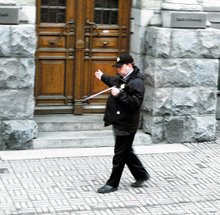A true test of the device would have one person hide the sample in one of several identical boxes. The box containing the sample would be chosen randomly by flipping a coin, rolling dice, or pulling a number out of a hat. The person would hide the sample and then leave. Only then would the user of the GT200 and the observers enter the test area and try to find the sample. The user would determine which, if any, box held the sample and report their answer to the observer. The box would not be opened then to check if he was right. The procedure would repeated at least 20 times if four identical boxes are used.
Before testing, the user should be able to test the device in the area, to make sure there is no interference which could be used later to claim the test did not work. Also, the user should be able to test the device by seeing if the GT200 can find the sample explosive when in plain sight.
NO PERSON should watch both the hiding and the searching for the explosive sample!! If they want to set up a camera on a tripod to record everything to ensure fairness and watch the video later, that is a perfect solution. But a person can give away clues as to where the real sample is hidden.
Please Thailand! Use a double blind test!!
An excellent example of such a test, that was used on the same device when it had the name MOLE is listed here:
http://www.justnet.org/Lists/JUSTNET%20Resources/Attachments/440/moleeval_apr02.pdf
http://www.bangkokpost.com/news/local/32244/ministry-begins-gt200-lab-tests-today
Ministry begins GT200 lab tests today
Disassembly an option if results not conclusive
- Published: 4/02/2010 at 12:00 AM
- Newspaper section: News
The Science and Technology Ministry is to begin practical and lab tests Thursday on the efficiency of the GT200 bomb detector.
A 13-member committee formed yesterday will start the tests by asking users to operate the GT200 to detect hidden bombs, Science and Technology Minister Kalaya Sophonpanich said.
The devices will also be tested with static electricity and magnetic frequencies.
Khunying Kalaya expected the team to conclude its tests in two weeks.
But if the chemical and physical tests do not yield satisfactory results, the scientists would disassemble the device for further examination, she said.
The committee appointed by Khunying Kalaya is made up of representatives of the detector's users, scientists and statisticians.
The house committee on national security yesterday held a meeting of relevant agencies to discuss the GT200's effectiveness.
Committee chairman Jeh-aming Tohtayong said security authorities in the lower South were insisting the device was effective as their inaccuracy rate was only once or twice every 20 times it was used.
Mr Jeh-aming called for an end to comments on the GT200's efficiency and for everyone involved to wait until this was proven scientifically by the ministry to avoid confusion.
But adviser to the committee Muk Sulaiman, a former Pattani MP, argued that residents of his province had told him that inconsistencies in detection by the GT200 scanner were troubling many local people.
Mr Muk quoted them as saying the device sometimes misidentified objects possessed by people as bombs and, and as a result, security authorities had detained innocent people. Most of the time, those people had been questioned in military camps for a couple of days before being released.
Deputy secretary-general of the Federation of Southern Teachers Sutsuai Bunchuai backed the GT200s, saying security authorities in the South should be allowed to continue using them.
"It's not necessary that the detector detect all bombs," Mrs Sutsuai said.



1 Kommentar:
Hi Lumpy.
Please keep up the good work and don't forget, there's another example of a double blind test of a bad explosives detector (Sniffex) here:
http://sniffextest.blogspot.com/
Kommentar veröffentlichen